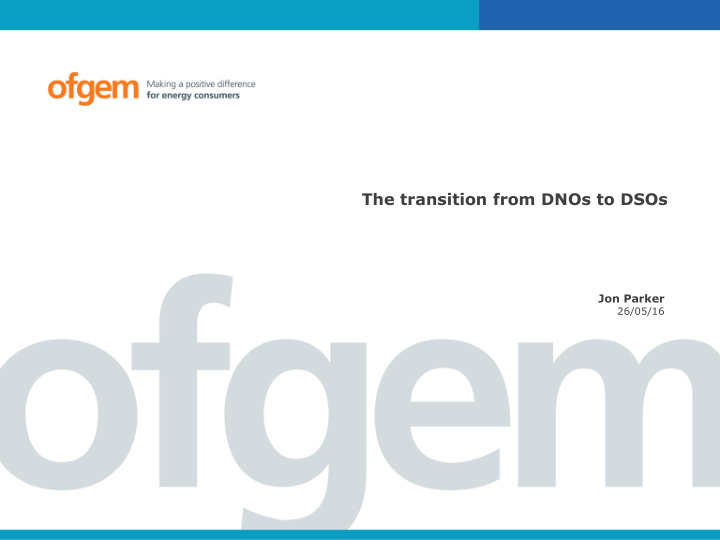



The transition from DNOs to DSOs Jon Parker 26/05/16
What is a DSO? We believe that at a high level (and building on existing responsibilities) DSOs should: • continue to be responsible for operating efficient, coordinated and economical distribution networks, but make active use of new technologies, providers and solutions in doing so; and • have an increased role in delivering an efficient, co-ordinated and economical wider system. The transition from the traditional DNO role to DSOs is already underway. The LCNF and new RIIO framework have been geared to encourage DNOs towards this. Some encouraging signs - DNOs are no longer just “passive” asset owners; they are increasingly adopting active network management approaches. But still early days. 2
What more needs to happen? Immediate no regret actions Further innovation by DNOs and embedding of active network management into their mainstream approach – needs a cultural shift Plus we see there is further work needed by DNOs together with TOs and the SO: Coordinated use of system resources for Coordinated network planning operations • Improved visibility (incl. data sharing), notification • Formalised framework around how network planning will and coordination processes between take into account wider interactions (eg clear DNOs/SO/TOs, identifying optimal cross-network coordination processes, common methodologies) solutions • Consider use of build/non-build solutions and use of • Provision of services between DSO/SO/TO optionality across transmission & distribution • There is significant scope to address issues through market based approaches • We expect industry to work together and come forward to discuss regulatory /commercial barriers they may encounter and how solutions could be developed 3
Potential further future changes Illustrative models Network planning: To support coordinated and efficient network planning SO RECOMMENDATIONS SINGLE PARTY PLANNING SO role in assessing options (at T & D) and providing Single party responsible for planning the system – recommendations to relevant parties on which likely overall , at certain voltage levels or in specific areas to most economically meet system needs Operational coordination: To support optimal use of connected resources and network management approaches across the system COMBINED NETWORK AND BMU-LIKE A MARKET FREQUENCY MANAGEMENT ARRANGEMENTS PLATFORM Either SO enhanced Parties procure SO considers combined bids / involvement in distribution embedded actions offers, DSO dispatches or network operation via platform . takes actions as needed . SO DSOs and SO / TOs DSO amalgamates bids and overlay locational offers, reflecting own actions PLATFORM and notifications from network restrictions DSO DSO embedded providers or value signals Or DSO joint responsibility for frequency and constraint Distributed providers (incl. aggregators and community energy providers) 4 management in a region submit bids / offers for adjusting output or services Internal Only
Recommend
More recommend